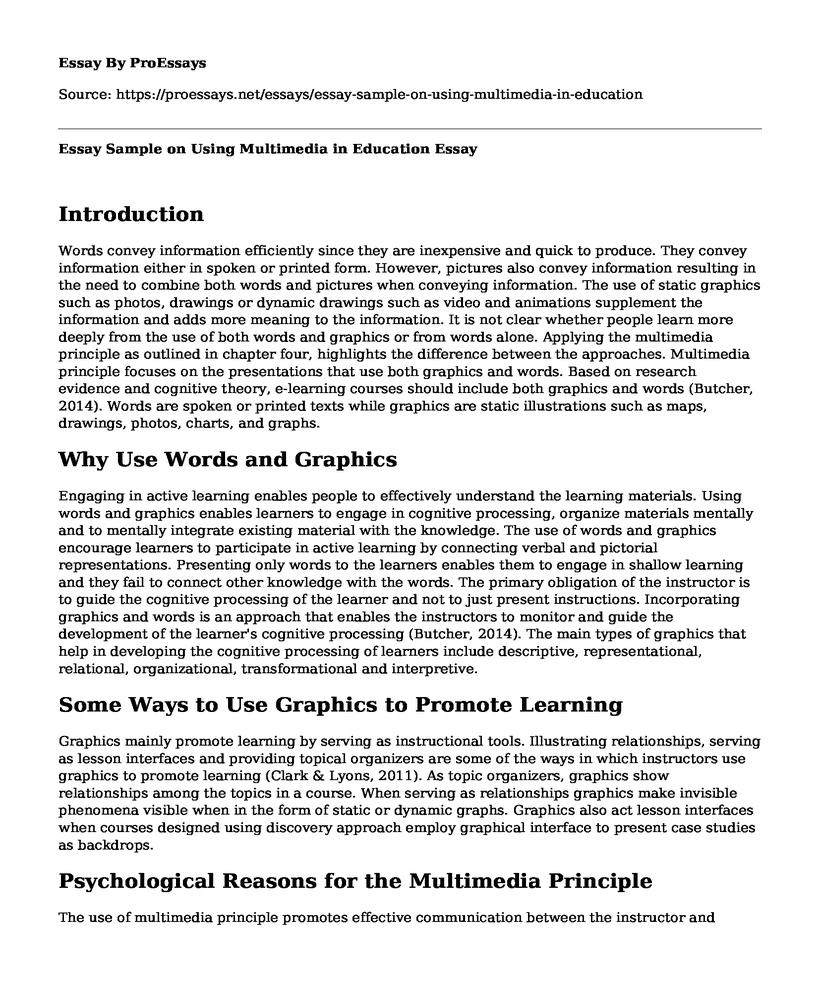Introduction
Words convey information efficiently since they are inexpensive and quick to produce. They convey information either in spoken or printed form. However, pictures also convey information resulting in the need to combine both words and pictures when conveying information. The use of static graphics such as photos, drawings or dynamic drawings such as video and animations supplement the information and adds more meaning to the information. It is not clear whether people learn more deeply from the use of both words and graphics or from words alone. Applying the multimedia principle as outlined in chapter four, highlights the difference between the approaches. Multimedia principle focuses on the presentations that use both graphics and words. Based on research evidence and cognitive theory, e-learning courses should include both graphics and words (Butcher, 2014). Words are spoken or printed texts while graphics are static illustrations such as maps, drawings, photos, charts, and graphs.
Why Use Words and Graphics
Engaging in active learning enables people to effectively understand the learning materials. Using words and graphics enables learners to engage in cognitive processing, organize materials mentally and to mentally integrate existing material with the knowledge. The use of words and graphics encourage learners to participate in active learning by connecting verbal and pictorial representations. Presenting only words to the learners enables them to engage in shallow learning and they fail to connect other knowledge with the words. The primary obligation of the instructor is to guide the cognitive processing of the learner and not to just present instructions. Incorporating graphics and words is an approach that enables the instructors to monitor and guide the development of the learner's cognitive processing (Butcher, 2014). The main types of graphics that help in developing the cognitive processing of learners include descriptive, representational, relational, organizational, transformational and interpretive.
Some Ways to Use Graphics to Promote Learning
Graphics mainly promote learning by serving as instructional tools. Illustrating relationships, serving as lesson interfaces and providing topical organizers are some of the ways in which instructors use graphics to promote learning (Clark & Lyons, 2011). As topic organizers, graphics show relationships among the topics in a course. When serving as relationships graphics make invisible phenomena visible when in the form of static or dynamic graphs. Graphics also act lesson interfaces when courses designed using discovery approach employ graphical interface to present case studies as backdrops.
Psychological Reasons for the Multimedia Principle
The use of multimedia principle promotes effective communication between the instructor and learners. It also helps instructors deliver information in different forms such as graphs, photos, animations, videos, and narrations. It helps the learners to mentally construct and connect both verbal and pictorial representations (Clark et al., 2011). Use of multimedia principle also enables learners to engage in active learning. The significance of the multimedia principle is, however, not equally applying to all the learners. The principle mainly works best to novices than experts.
Animations`
The additional use of animation makes multimedia principle even more effective to the learners and instructors. Animations are active mediums making them the best form of illustrations that depict both movement and changes. They also promote active processing since learners have to animate changes mentally. Use of animations is also an effective approach in multimedia principle since it helps instructors to illustrate procedures effectively. Animations serve as interpretive graphics and instructors should incorporate it in the e-learning process to promote the development of cognitive processing among the learners.
References
Butcher, K.R. (2014). The multimedia principle. In R.E.Mayer (Ed.), The Cambridge handbook of multimedia learning (2nd ed., pp. 174-205). New York: Cambridge University Press. Provides an up-to-date review of the evidence for the multimedia principle.
Clark, R.C., & Lyons, C. (2011). Graphics for learning (2nd ed.). San Francisco: Pfeiffer. Summarizes research and practice on incorporating graphics into multimedia instruction.
Cite this page
Essay Sample on Using Multimedia in Education. (2022, Nov 11). Retrieved from https://proessays.net/essays/essay-sample-on-using-multimedia-in-education
If you are the original author of this essay and no longer wish to have it published on the ProEssays website, please click below to request its removal:
- Psychology Paper Sample on Children's Cognitive Development
- Essay Example on UAE Nuclear Plant: 5600MW Source of Energy for the UAE
- Essay Example on a Decade Later: My Worst Encounter With My Grandfather
- John's Character Development: From Trust to Mistrust at Age Two - Essay Sample
- Essay Example on Global Business Dynamics: My Experience with Samsung Group
- Free Essay Sample on The Challenges of Teaching History
- Example on Personal Experiences Related to Behavior Economics







